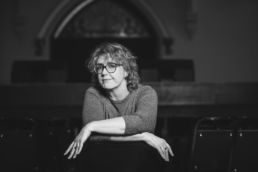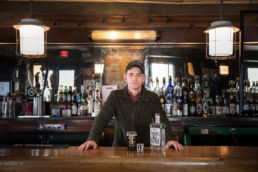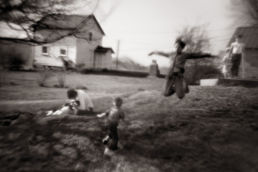words SAM LOWE | photography DAMON WILSON
Andrey Kozakov stood patiently in the cold outside of his hybrid studio/apartment waiting for me to arrive. It was our first time meeting. I was late, but he was gracious. He had been described to me as a Ukrainian painter of works that look “a bit cubist.” Into my mind had come images of Pablo Picasso and George Braque, brooding men in black-and-white photographs, with perhaps little to say other than what their canvases conveyed.
Andrey, however, is none of that. He is amicable and talkative, and he is colorful—his arms are ornamented with tattoos from his wrists up.
We walk past finished canvases on walls and in-progress works on easels to arrive at his eat-in kitchen, where we share conversation and cups of hot tea. On the table are sketches in a style that differ radically from his paintings. One is a huge anglerfish with a treehouse on its back. Andrey explains that these sketches are for a sculpture—maybe twenty feet high—that he is preparing to construct in France during a workshop. It is inspired by a Slavic fairy tale.
His current paintings don’t reflect anything so surreal. People who misunderstand his work have described them, he says, as “painting squares.”
“My usual customer understands my geometry: other designers, architects, people who know math.”
He has no mathematics background nor any formal training in any building discipline, but his catalog of large-scale paintings suggests otherwise. It is filled with buildings and implied buildings with walls and spaces that seem to turn inside out. At first two-dimensional, after quiet viewing the paintings start to open up into virtual worlds of volume and mood—illusions attributed to Kozakov’s expert use of color.
Kozakov’s sculptures and paintings, with their vastly different styles, may appear to have been created by two different artists, but he explains they are both the result of exercises in fantasy. Both styles have emanated from a creative flow state, and what comes from that state is a product of pure happiness. And when you do something out of happiness, Kozakov says, “You can’t help but share it.”
He seems to have always had this characteristic of vibrant buoyancy, even when he and his family were surrounded by a society that was less than accommodating.
“I grew up in the Soviet system. Everybody was always nosey—always in your business. Walk this line. Think this way. No questions.”
He was never fully encouraged to follow his creative urges, even after coming to America in the mid-1990s. “I almost got into a fistfight with my stepdad,” he recounts. Kozakov quotes his stepfather: “Work is not something you enjoy, it’s what you do to support your family.”
The message was in deep contrast to that of his landscape-painting father, divorced from Kozakov’s mother when their son was very young. His father was, by Kozakov’s colorful description, the poster boy of the bohemian artist. “He was having a great time. Why wouldn’t I want to be like that? When I would skip school, I’d always know where I could find him.” Hanging out in the subway with his fellow artists, making a quick buck by doing small portraits for passersby in a large subterranean area near the coffee shops.
Kozakov circles back to his stepfather. “He was a part of an old, rusty Soviet way of thinking. I know other Russians who come here [to America] and are just lost. They say, ‘No one cares about me here!’ But that’s the gift! No one gets in your business.”
The freedom to explore and create endlessly was kickstarted when one of his high school teachers approached him during class. He had been doodling. “I had just drawn this realistic, 3D sports car, and she asked if she could have it. In Russia, the schoolteacher would just rip it up. Then she tells me, ‘Andrey, come with me.’”
The artist didn’t understand what was happening. He spoke little English. He was convinced he was in trouble and assumed he was being taken to the principal’s office. To his surprise, she brought him to an art class. Before long, he had multiple art classes on his schedule.
“She was great. She really pushed me. She’d write me notes—which my friends helped me interpret. She helped me question what I was doing.” As a result of her encouragement, he studied and experimented with the organic forms of surrealism and dreams.
“It was good practice for learning how to mold things together,” he says, “but I wanted more.”
Surrealism didn’t offer him a language expansive enough to share what he wanted to share. After taking jobs as a furniture restorer and piano restoration specialist, Kozakov found his creative voice. With hard shapes and color, lacquers and powders, he could turn things around over and over in his head, ultimately creating whole worlds. With every literal twist and turn of a shape, an entirely new idea would spring forth.
It is this process that he brings to his current work—shapes of light and form, colors that render moods. Is it surrealism? Not really. Cubism? Not quite. When first cultivating this approach, his then wife, also an artist, said, “It looks constructivist!”
After researching constructivism, a movement birthed in his own homeland, Kozakov had to agree. “It opened my eyes. My work was already near to that.”
But his work sits outside all these labels. It has the precision of constructivism but evokes the mood of surrealism. What matters though is the fortunate viewer can get lost in the creations of his free exploration—Kozakov’s gift to us.



